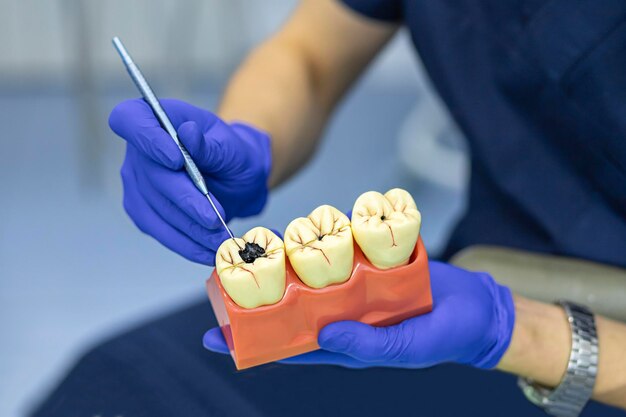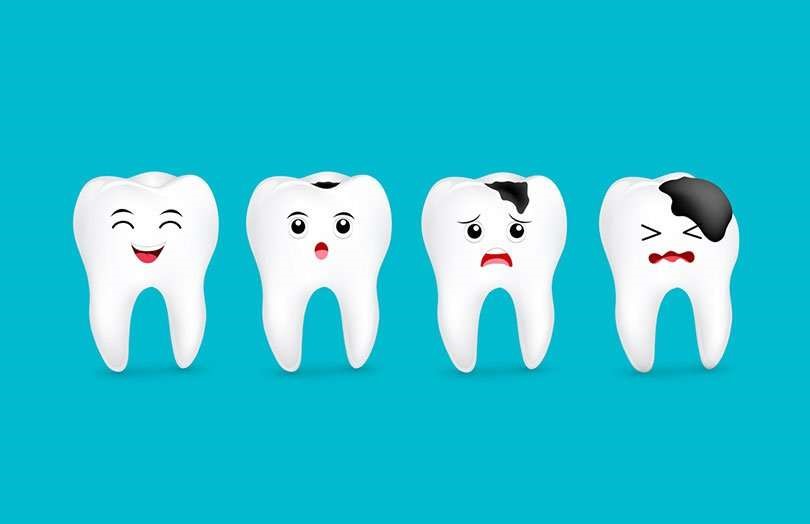
20 May ALL ABOUT CAVITIES

Cavity means what?
Cavities occur when a tooth is decayed. How does that happen? Well, when your outer tooth surface also called enamel, gets damaged, then the tooth is said to be decayed or has caries. When the tooth starts developing caries the surface tends to break down and the person feels like the tooth is developing holes.
When Cavities are not treated at the early onset, they can tend to aggravate and increase the level of discomfort due to an increase in bacterial infection.
How does a cavity occur?
When teeth are not cleaned as they are supposed to with the help of brushing and professional cleaning methods, the tooth is susceptible to cavities. When the teeth are not cleaned well, there is the deposition of a smear layer which is soft in consistency from foods that are consumed. Foods rich in starch and sugar have a tendency to stick to the tooth surface and when this happens it is necessary to get them cleaned either by brushing or gargling very well. If this is not carried out, then the soft smear layer around the tooth surface hardens with time. This hardened layer around the tooth surface is called calculus which does not go away with normal brushing.
Prolonged deposition of this layer on the tooth surface removes the minerals from the enamel (outer layer of the tooth) causing it to create holes. This is the first stage of cavity formation.
What are the different stages of cavity formation?
- Cavity involving the Enamel: Enamel is the hardest tissue in the oral cavity. Demineralization that is the process in which the acid released from the bacteria breaks down this enamel structure to cause damage and create holes in the enamel surface. This is the initial stage where in the cavity is concentrated only in the enamel layer and does not extend into the next layer.
- Cavity involving the dentin: Dentin is the underlying layer of the enamel. This layer is softer than the enamel. The soft consistency makes it more sensitive and susceptible to acid breakdown. Being a sensitive layer, the patient experiences sensitivity and pain in some cases, making them realize the presence of a cavity or that something is wrong with that particular tooth.
- Cavity involving the pulp: Pulp is the innermost layer of the tooth. It is that part of the tooth that contains all the nerves and fibers that supply blood and nutrition to the tooth in order to keep the tooth healthy. When the cavity reaches the pulpal tissue, the patient is bound to experience pain. The tooth becomes sensitive to food items and also temperature such as hot and cold food items. Involvement of pulp cause the tissues around the tooth area to swell up due to the bacterial infection.
- Formation of abscess: when the cavity reaches the pulp it causes infection and pus formation at the bottom of the tooth, this pus formation is called an abscess. Abscess formation causes acute pain which can also radiate along the entire jaw. During cases like this, the issue needs to be addressed immediately and in extreme cases, the tooth may require extraction.
How to treat different types of cavities?
- Cavity involving the Enamel: During the initial stage, cavities involving the enamel can be treated with a filling only. During this filling procedure, the dentist will clean up the entire area and fill it up with biocompatible cement like resin or composite. These cement come in different shades of the tooth so that the filling can replicate the same tooth and look as natural as possible.
- Cavity involving the dentin: When a cavity is detected in the early stage in the dentin layer, then it can be treated with filling only. When a large portion of the dentin is involved and the cavity is too close to the pulpal area, then fillings turn out to be a little tricky. It may require an indirect pulp capping procedure to protect the pulpal tissue. However, in such cases, the chances of the cavity progressing toward a root canal treatment are high and the patient is also made aware of the same.
- Cavity involving the pulp: In cases of this, the tooth requires a root canal treatment to clean the infection and at the end of the procedure the tooth requires a crown. In case of severe infection, the abscess is formed at the bottom of the tooth, in such cases, the bacterial infection is resolved with the help of antibiotics and may require additional sitting during the root canal treatment. In some extreme cases, the tooth may also undergo extraction which is best known to the treating dentist.
Cavities at the initial stages are mostly asymptomatic in nature. The patient rarely feels any patient. The only way to detect this is through regular check-ups. The Dentist can identify and address this issue at the very beginning before it can worsen in the future. Any discomfort, pain, or sensitivity can be cured by just making an appointment with a dentist, and you any dental issue that needs attention can be resolved immediately.




